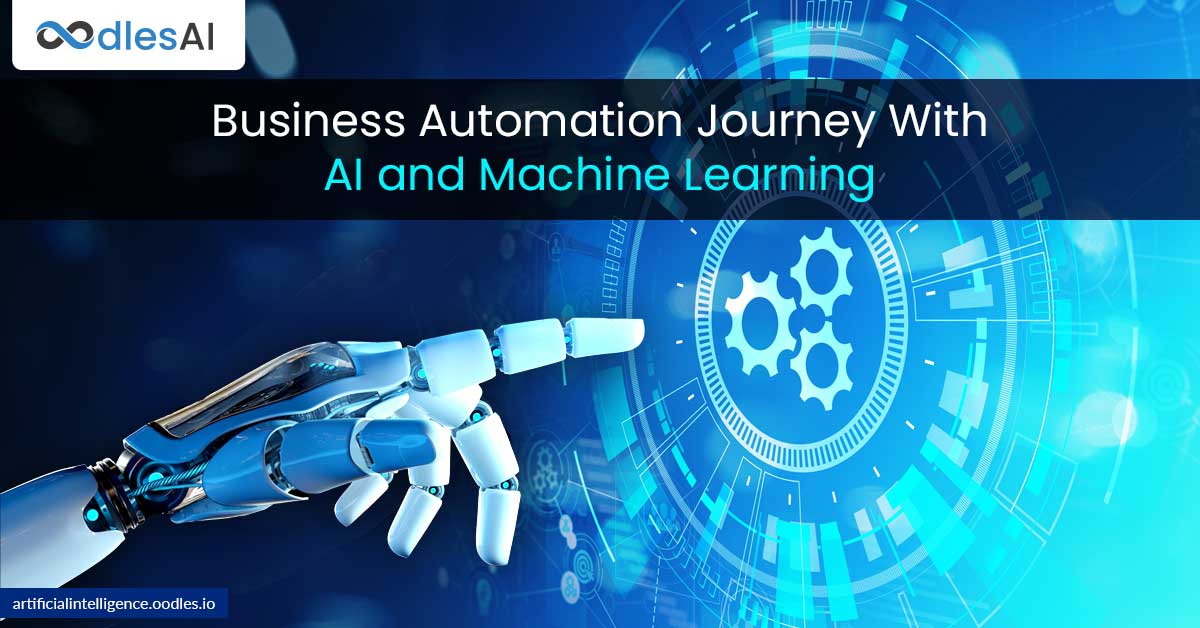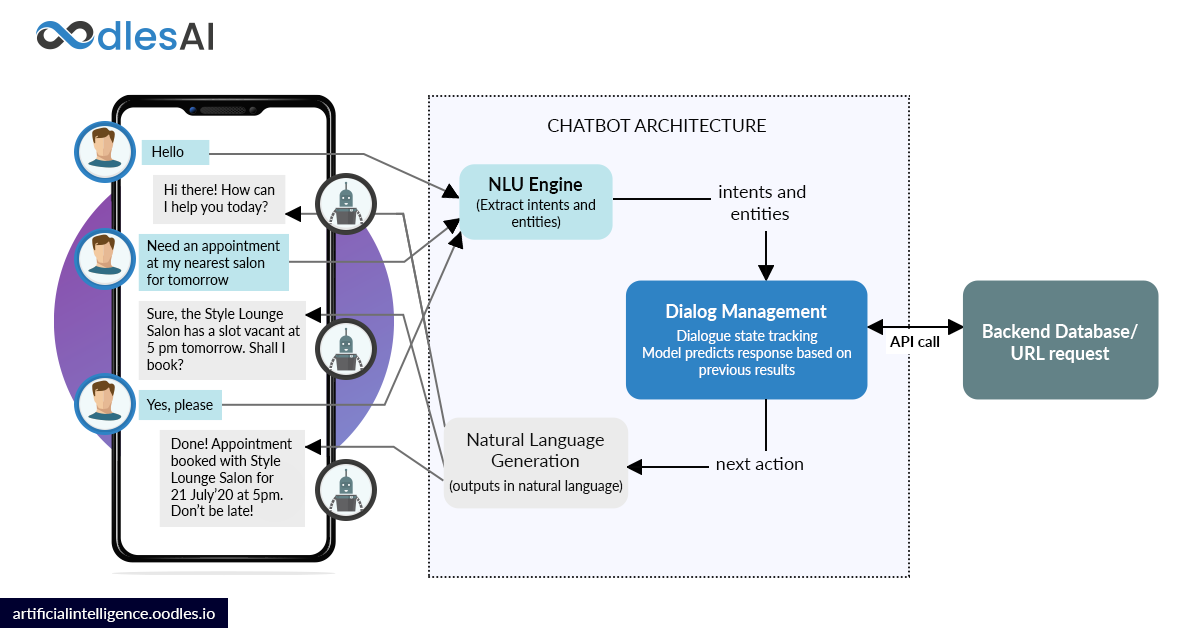Effective AI Applications For Business Automation Journey 2020
Sanam Malhotra | 29th July 2020

As efficient as it sounds, Business Process Automation is as layered as enterprises may find. For organizations chasing the Industry 4.0 vision, AI applications for business automation journey are indispensable to achieve economies of scale. A strategic implementation combined with appropriate data training constitutes the layers of AI-driven business automation.
We, at Oodles, as an emerging Artificial Intelligence Development Company, decode business automation while highlighting key AI applications for attaining operational efficiency.
Understanding the Dynamics of Business Automation Journey
Business Process Automation (BPA) is a systematic approach to improve conventional business processes using advanced technologies such as AI and machine learning. BPA does not involve firefighting, rather it entails a strategic, priority-based implementation aimed at increasing operational efficiency and employee productivity.
A report by Shanhong Lui projects the market size of BPA to reach $12.7 billion in 2021 from the current $11.2 billion globally.
Termed as ‘Intelligent Automation’, BPA powered by AI involves a continuous integration of software solutions that automate rule-based and cognitive tasks. From employee onboarding and contract management to accounts payable and customer services, AI offers scalable automation solutions for the wider organization.
Based on the process complexity, BPA technologies can be categorized into four breakthroughs as below-

1) Robotic Process Automation (RPA)
The basic gateway for enterprise automation, RPA involves software solutions that mimic rule-based operations. Use cases include website scraping, order processing, data entry, and migration, OCR, etc.
2) Machine Learning (ML)
Developed and trained using data, machine learning models automate classification and prediction-based processes with minimal programming. Algorithms fuel the functioning of ML systems for automating customer segmentation, data extraction, demand forecasting, recommendations, etc.
3) Natural Language Processing (NLP)
NLP involves the understanding and analysis of unstructured text or voice inputs. Similar to machine learning, NLP uses algorithms to map the intent, context, and sentiment of the input speech. Use cases cover our very own chatbots, virtual agents, customer services, self-help centers, and more.
4) Deep Learning (DL)
A subset of ML, deep learning brings together complex algorithms, neural networks, and cognitive capabilities to recognize patterns and relationships in large datasets. It builds on ML findings to further anticipate credit risks, optimum product development practices, identify verification, and other critical thinking problems.
The reason why the Mckinsey Global Institute reports that only a few organizations succeed in BPA is its strategic implementation. Starting from process identification and technology selection to IT team involvement and evaluation, organizations lack a streamlined approach, sync, and implementation.
At Oodles AI, we understand the complexities and variations of every business process across industries. Our team of AI developers, architects, and data scientists come together to turn businesses future-ready by channelizing process automation journey efficiently. The next section presents an expert guide to welcoming AI-driven automation into business processes.
Expert Guide to Business Process Automation with AI

4 Function-specific AI Applications For Business Automation
1) Machine Learning-based OCR
Traditional Optical Character Recognition (OCR) systems demonstrated limited abilities in recognizing structured and unstructured texts, leading to inefficiencies and errors. Evolved OCR systems backed by ML tools such as Tesseract OCR can automate data capture and extraction from variable documents.
While traditional systems required human efforts to restructure templates, ML-based OCR automatically identifies different layouts, fields, contrast, and variable text placement.
Cost and time effectiveness, efficiency, and accuracy are the immediate benefits of employing AI-powered OCR systems with far-reaching applications including-
a) Invoice Processing
b) Employee Onboarding
c) eKYC
d) Healthcare data management
e) Contract management, and more.

The Oodles AI team recently build an AI-OCR model for extracting data from identity cards such as Aadhaar cards, Passports, PAN cards, and driver licenses.
Also read | AI-powered Receipt Digitization with OCR Systems for Businesses
2) Face Recognition for Attendance Management
Deep learning is the powerhouse behind face recognition technology that is gaining momentum across surveillance, security, and safety verticals. For large organizations, face recognition is emerging as a technology-led way to manage resources to replace traditional biometrics systems.
Amid COVID-19 fears, face recognition is gaining traction as a contactless technology to monitor employee activities and enforce precautionary measures.
Featuring real-time track and alert functions, face recognition technology offers dynamic applications such as-
a) Tracking employee attendance
b) Ensuring workplace safety with the detection of smoke, safety gear, etc.
c) Monitoring assets remotely with real-time inspection of equipment.

As an established Computer Vision Development Company, the Oodles’ AI team has built a CNN-based employee attendance system. The model is integrated with a front-desk video camera that tracks employee movements with over 95% accuracy achieved.
Also read | AI for Video Analytics: Enterprise Applications and Opportunities
3) AI-powered Cognitive Chatbots
Chatbots have become a household name, so much so that by 2020 humans are expected to interact with chatbots more than their spouse. With chatbots sprawling across digital channels, it is imperative for enterprises to identify the right virtual assistant that enhances customer experience. While rule-based chatbots follow a pre-defined script, intelligent virtual agents learn from data to provide human-like interaction.
From healthcare chatbots to shopping assistants, AI is empowering businesses with cognitive capabilities to engage customers with quality responses and suggestions.

‘Self-learning chatbots’ are difficult to build but highly effective once mastered. From traveling and restaurant bookings to healthcare and customer support, cognitive chatbots are the winning AI applications for business in 2020.
Also read | Chatbot Development in 2020: An Expert Guide to Tools & Techniques
4) Personalized Marketing Tools
In light of the ongoing pandemic, offline marketing tactics such as events, exhibitions, and trade shows are quickly becoming obsolete. Going digital is the only visceral way forward to stay connected with customers, clients, and partners for sustaining the market position.
AI’s role in digital marketing techniques is constantly expanding with personalized recommendations, lead generation chatbots, customer segmentation, and other AI applications for business.

We, at Oodles, have witnessed a spike in business adoption of personalized marketing interfaces for automating customer interactions across insurance, healthcare, eCommerce, and other businesses.
Also read | AI-powered Digital Marketing Tools For Post-COVID Business Revival
Oodles AI: Your Automation Partner for Building Data-driven AI Applications for Business
The Oodles AI team reflects on the current business downturn caused by COVID-19 as an opportunity for disrupting legacy systems. We harness the power of AI, machine learning, NLP, deep learning, and other emerging technologies to generate value from process automation.
Our AI applications for business automation journey 2020 encompass robotic and cognitive solutions, including-
a) Domain-specific employee management systems
b) Cognitive chatbots
c) Personalized recommendations
d) ML-based OCR systems, and more.
We follow a strategic approach to BPA that matches business requirements with customized automation while accelerating operational efficiency and revenues.
Join forces with our AI development team to unlock new opportunities for your business automation.



